A Month with a Mac: A Die-Hard PC User's Perspective
by Anand Lal Shimpi on October 8, 2004 12:05 AM EST- Posted in
- Mac
Perfect Multi-tasking
So far, I've described OS X's multi-tasking as very similar to what is currently available under Windows, but where OS X sets itself apart is in a little feature called Exposé (note that typing an accented "e" is extremely easy under OS X - ALT-e followed by the "e" key or any vowel will do just that).By default, Exposé is activated by one of three function keys - F9, F10 or F11. Each function key serves a different purpose, each of which is a feature of Exposé. The theory behind Exposé is simple: it is a way of getting to a specific window on your desktop as fast as possible.
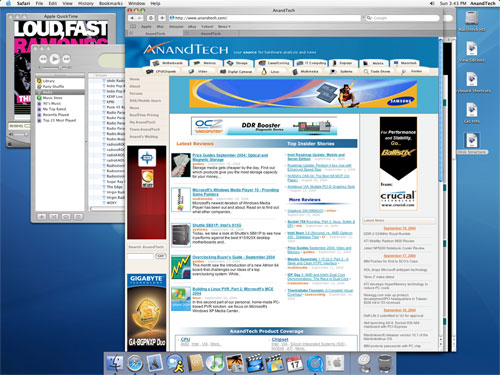
We start with our cluttered desktop...
Click to enlarge.
Hitting F9, for example, will cause Exposé to zoom out all of your active visible (unhidden) windows and essentially, tile them across your desktop. Then, using either the keyboard or the mouse, you can select the window that you want and everything goes back to normal, with the window that you have selected appearing in the foreground. The rest of the windows are untouched and are all in their original positions. The window that you selected is also in its original position; it is simply moved to the front so that you can see it.
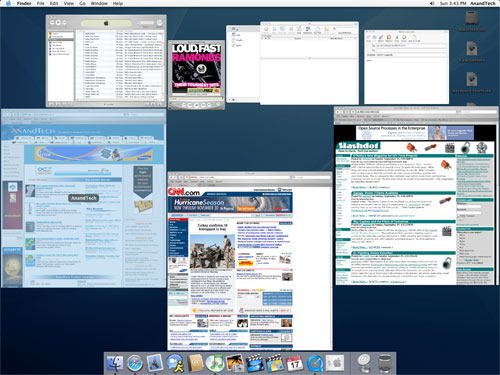
Hitting F9 activates Exposé across all applications.
Click to enlarge.
If you don't want to Exposé all windows, you can just Exposé the windows within a particular application (F10 by default), which is extremely handy for dealing with tons of images in Photoshop for example.
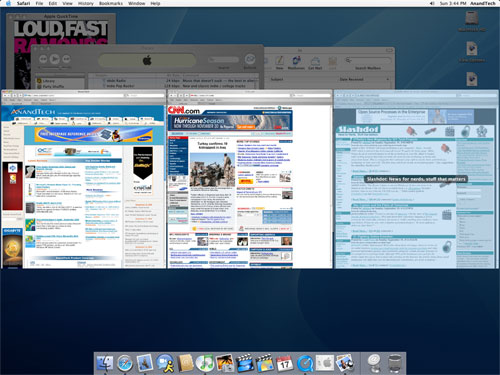
Hitting F10 activates Exposé across only a single application's windows.
Click to enlarge.
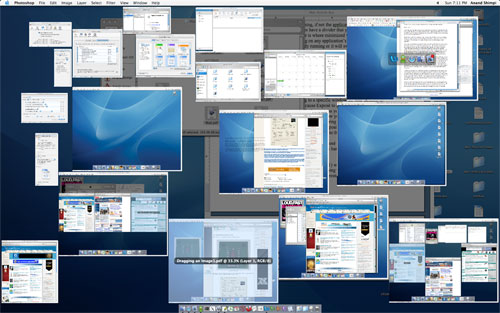
Another example of Exposé's usefulness in editing all of the images for this article in Photoshop.
Click to enlarge.
The final Exposé function lets you view your desktop (F11), which, to me, was like a more polished version of Windows-D, since after I was done doing whatever it is I needed to do on the desktop, Exposé deactivated and my screen was restored to its original state.
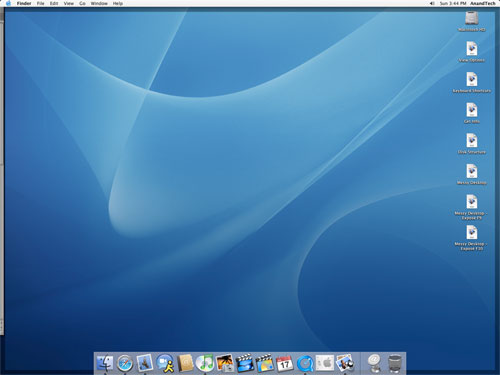
Hitting F11 reveals the desktop.
Click to enlarge.
The beauty of Exposé is difficult to convey in text alone. Honestly, the best way to evaluate it and understand its potential is to use it - luckily, there are Apple stores for this very purpose. Keep in mind that Exposé is very customizable as well and the three function keys that I mentioned above, although the defaults, are not the only ways that you can configure OS X to activate Exposé.
The benefits of Exposé are numerous. If you ever feel overwhelmed by having too many windows open, Exposé definitely alleviates that feeling as you don't have to tab through multiple applications to finally get to the window that you want. While Exposé does make having only a single display better, heavy multi-taskers will still enjoy the benefits of a dual display setup.
Since the OS X desktop environment is completely OpenGL accelerated, the performance of features like Exposé are not CPU limited - instead, they are GPU limited. Luckily, using Exposé with many windows open is not very stressful on even a Radeon 9600, but you do run out of video memory very quickly - in which case, your system ends up swapping to main memory over the AGP bus, making the Exposé animation considerably choppy. It seems that the sweet spot for more than a handful of windows open is around 128MB of video memory, with 256MB being perfect - needless to say, I found the mere 64MB that came on the Radeon 9600 which shipped with the system to be too little. There is no detriment to functionality if you don't have enough video memory; the Exposé animation simply becomes more choppy (which can be annoying on a $3000 system).










215 Comments
View All Comments
vladik007 - Thursday, March 31, 2005 - link
" highly paid Windows admin / Cisco Engineer "geeez ... new low bottom.
MarshallG - Monday, February 28, 2005 - link
I was thinking about getting a Mini Mac. But with a 1.25 GHz CPU, it's about 1/4 the machine that Anand tested.Will I be disapointed by its performance at the same kinds of tasks Anand mentioned? I realize that I'll have to upgrade to maybe 1 GB of RAM.
BikeMike - Sunday, January 30, 2005 - link
re: OSX dialogue keyboard shortcuts - like in Word, where 'd' means 'don't save' and 'return' & 'enter' apply to the highlighted button, many OSX apps do not require a modifier key, such as 'alt' or 'command'. The experience of discovery is guesswork, yes, but if you don't look for a modifier key, you get better at guessing. For example, in iTunes dialogues, 'y' means, you guessed it, 'yes'.pyramiddown - Saturday, January 29, 2005 - link
Ctrl-Tab to switch tabs in FirefoxOmnisAudis - Wednesday, January 26, 2005 - link
Great article! very long winded, but awesome. I am a long time Mac user, with an XP machine at home and an iBook at work.I thought it was very interesting you found nothing snazzy about iCal. It is my FAV Apple app!! It is the most powerful, easy to use calendar I've come across. And it seems to be able to do things that XP Outlook can't. For one thing, I can publish a calendar so that other users can subsribe to it. When I make a change to that calendar, they see those changes.
I can have TONS of calendars. In outlook, my boss can only have one (and view others). At my work place, we have 20 productions going on. It would be great if he could generate a calander that we could subscribe to for each show. As changes occur, we would get them without a memo going out, and everyone updating their calendars.
Plus, I can subscribe to a season calendar of the Yankees! So as I publish calendars for visiting artists, and I subscribe to one for entertainment.
I'll stop now. But I think you should revist iCal. Look at it from a multi-user point of view.
Thanks for the objective article. I've learned a few things about OS-X!
KingKuei - Sunday, January 16, 2005 - link
Anand,Wait til you see Tiger...
Updated Safari with significantly improved speed and capabilities.
Add the Spotlight feature (comprehensive demo at MacWorld Expo --> don't miss the jab at Bill Gates when the Spotlight feature crashes... one word: backup)
Dashboard (sorry to the company that made it, but the feature is coming free to Tiger and I can't wait!)
And for the first time, fully takes advantage of the 64-bit processing core of the G5.
Anand, I dare you to write a follow-up review on that dual-2Ghz of your's when Tiger ships ON SCHEDULE later this year!
macgeek - Saturday, January 1, 2005 - link
It is go glaringly obvious to any Mac user that you did understand half of what you were writing about. Just a few glaring omissions from your article:* Unix-based, and you have full control of Unix through the terminal.
* No spyware or viruses - I don't even run anti-virus because there has NEVER been a virus for OS X. NOT ONE!!!
* Why do you think Office 2004 sucks? Probably because it's made by Microsoft! Ever heard of OpenOffice?
* Address Book - not only is it integrated into mail, but it's integrated into OS X.
* Guess you didn't spend much time looking for it, because you could have had Trillian for Mac OS X as well.
* Browsers - Yeah, Safari needs some work, but you've got quite a few to choose from. Oh, and Safari isn't the Lincoln Tunnel of security holes that IE is either. And if you so choose, you can simply drag Safari to the trash can and never use it again. Now try that with IE.
* ipfw vs. Windows Firewall - Puuhhlleeeeasseee!! What does microsoft give you? A firewall that a third-grader could get through and that allows EVERYTHING OUT!!!!! I quite like having the ability to customize ipfw in terminal to have a firewall that is truly an industrial strength firewall.
* Root authentication - whenever a program needs to install or modify system files, you have to authenticate as root. Too bad that when you're logged on as an Admin in Windows it's "anything goes" and you have no choice when that nasty website throws a dll file into the Windows directory.
* No mention of any Apple Pro Apps like Final Cut HD. I've seen what happens to P4 systems when they try to render video in Adobe Premiere - they crash. You have to drop at least an extra $1000 for a Canopus or high-end Matrox capture card to have a chance of competing with a dual G5 system. My PowerBook G4 1.5 GHz renders video better than my P4 3.4 with 1GB of HyperX PC3500.
* No mention of integrated Bluetooth, or how simple it is to configure networking, or of integrated Firewire 800.
Shoddy research, and a poor attempt overall. It's easy to see that you liked the G5, but you didn't even scratch the surface before you wrote that article. And if you honestly think that OS X crashes as much as Windows, you REALLY must not have known what you were doing.
And I qualify this as my day job is as a highly paid Windows admin / Cisco Engineer. I know Windows XP / 2k / 2k Server and Win2k3 inside and out, and they can't touch the possibilities of OS X. The only area that I'll give you is gaming. That's why I have a top-o-the-line AMD.
hopejr - Monday, November 8, 2004 - link
I'm quite impressed with this article. I'm a recent switcher (august 04) and can say that I much rather OS X to any other OS that I've used (every single released version of windows from 1.03 to Longhorn 4074, many Linux distros, and mac os from system 6 to OS X Panther).I didn't go for a beefed up PowerMac G5, but I did buy a 12" iBook G4 with student discount (April 04 model). I've found that these are the cheapest decent notebooks out (as I can't stand celerons :P), and for a 12" at just AU$1520, I think it was a bargain (most PC 12" laptops are twice that much with almost identical specs).
I also like the fact that I have seemless networking with my Windows machines. Another thing I like is that I can do all the stuff I need to do on linux (for University) on my iBook because of its unix base.
In regard to the point someone made (i can't remember which post) about this article testing multitasking on a dual processor environment, I find that my single processor G4 laptop is still much better at multitasking than the latest Windows PC with hyperthreading, or even an AMD64, that I've used. Maybe that's just me though :P.
I've found that I'm more productive on OS X compared to windows, especially with all those keyboard shortcuts.
BTW, post #207 is right about the choice mac users have to make, I make those choices now, and know exactly when I want a program to close, or when I just want to close a window. I also find command-H and command-option-H very useful with reducing screen clutter.
I haven't always liked Macs. I hated them mainly because the classic OS was a pain to use in my opinion with little control over it (I am a DOS user, so I like being in control of my machine using a command prompt). When OS X came out (especially Panther), my hatred disappeared.
macgruder - Saturday, November 6, 2004 - link
Pretty good and fair review.I wish people would stop saying an App should quit when you close the last window. This is not useful in many situations. e.g. I'm in Photoshop, I have a window open, and I'm done with it, but am going to continue working. Close the windows, oops Photoshop quits.
Mac users are used to making the following choice:
a. I want to close a window (command-W)
b. I want to quit the App. (command-Q)
These are 2 distinct actions. To me closing a window is just that, and shouldn't be connected to the independent action of quitting an app. If I'm done and I have ten windows open, I just command-Q, and the windows(if not saved) close automatically anyway. As far as I can see Windows seems to be forcing you (correct me if I'm wrong) to do an unconnected action, when you may not want to.
Humancodex - Friday, November 5, 2004 - link
I make a link of the article to: http://www.macbidouille.com (french) in forum "switch", everybody like your "objectivité", and like you to push the Mac test trial more often!